You are viewing the article How To Cut A Lemon 5 Different Ways at Tnhelearning.edu.vn you can quickly access the necessary information in the table of contents of the article below.
Just a little squeeze of lemon juice can transform a dish from bland and boring, to bright and exciting. And for a lot of beverages and cocktails, there’s really no substitute.
Pre-bottled lemon juice? No thank you.
Yes, fresh lemons are an incredibly versatile ingredient.
Today, I’ll be sharing 5 different ways to cut a lemon. By the end, you’ll know how to cut lemons for juice, garnish, and everything in between.
In This Article
But First, Pick The Right Fruit!
No matter what you’ll be using your lemons for, it pays to be just a little picky in the grocery store. Taking a second to thoughtfully choose your lemons can mean the difference between the tart and juicy lemon you want, and the dry and disappointing one you don’t.
When picking lemons, look for ones that are firm with a little bouncy give. Stay away from any lemons that feel soft or mushy.
If you can, pick out lemons that have thinner skin and feel heavy for their size.

Especially if you’ll be using the zest of the lemon, avoid any lemons with dry spots, scarring, or discoloration on the skin.
5 Ways To Cut A Lemon
1. Wedge

Lemon wedges are one of the most common and versatile ways to cut a lemon. Wedges are used to add fresh-squeezed juice while you’re cooking, to a plate of food, oysters, or a drink, just to name a few.
You can let each person eating or drinking add the amount of lemon juice they want. And, you can easily use a small portion of a lemon without juicing the whole thing, which might be more than you need.
First, hold your clean lemon firmly on a cutting board and slice off the top and bottom, leaving you two flat ends.

Place the lemon on one of the flat ends so that it is standing vertically. Then, place your knife just off-center from the core and slice down all the way through.

Rotate the lemon and repeat that cut two more times, each time making the cut slightly away from the center of the lemon.
You’ll end up with three lemon “cheeks” and a core that should contain most of the seeds. Any remaining seeds should be easy to remove by scraping them off with your knife.
If you’d like, you can then cut the seedless thirds into whatever size pieces you’ll need.
Why not quarter the lemon first?: Another common method is to quarter the lemon and then make a slant cut on each quarter to remove the core and seeds. But, the “cheek” method requires fewer cuts, making it faster, and it creates flat ends on each wedge that are easier to squeeze.
2. Slice

Lemon slices also have several uses. They are often used either directly on top of or underneath seafood or chicken while they cook. And they are commonly used as a garnish on the plate, to add flavor to cocktails, or in a pitcher of water or iced tea.
Round Slices

Place a clean lemon horizontally on your cutting board and hold it very firmly with your non-dominant hand. Then, keeping your fingertips out of the way and using your knuckles as a guide, slice down and forward through the entire lemon.
Move your non-dominant, guide hand slightly and repeat the process making the slices as thick or thin as you’d like. Use caution here since you’re cutting a round object that can easily rotate and roll while you’re slicing.
Half Moon Slices

Start by holding a clean lemon firmly on your cutting board and splitting it in half lengthwise, tip to tip.
Now, place one lemon half horizontally on your cutting board, cut side down.
Hold the lemon half in place and use your non-dominant hand as a guide to make your slices just like you would for full, round slices. This method is safer and easier because you created a flat surface which makes the lemon more stable to cut.
3. Supréme Or Segment
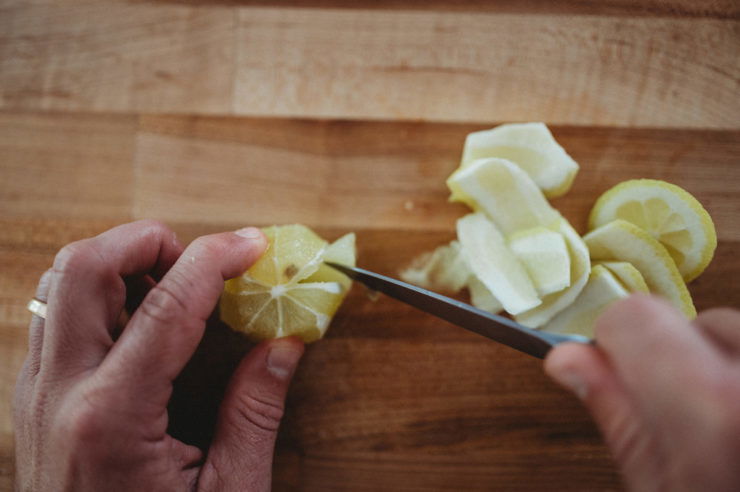
Lemon suprémes are like thin wedges without any membrane, pith, or skin. Just pure, juicy lemon flesh. Lemon suprémes are used when you’ll actually be eating pieces of lemon and not just using them for the juice or as a garnish.
Lemon segments add a more concentrated pop of acidity to dishes compared to using lemon juice. They work well in things like ceviche and salsas, or seafood, fruit, and vegetable salads.
First, hold a lemon horizontally on your cutting board and cut off both ends. You want to cut just deep enough that you expose the flesh of the lemon.
Next, stand the lemon up on one of its now flat ends and hold it in place with your non-dominant hand.
If you’re a beginner, place your knife on the inside of the pith (the white part between the yellow skin and the lemon flesh) and make a sawing motion as you follow the shape of the lemon down to the cutting board.
Rotate the lemon and repeat until all of the skin and pith is removed.
As your knife skills improve, try moving from a sawing motion to one clean slice to remove each band of skin. You can either pull from the heel to the tip of the knife or push from the tip to the heel. This will allow you to prep faster, lose less juice, and up your kitchen street cred.
Now, take your peeled lemon and cup it in your non-dominant hand.
Finally, use your knife and cut against each membrane, following the natural segmentation of the lemon. Be very careful, use light pressure with your knife, and don’t cut more than halfway through the lemon. There’s nothing to stop your knife’s blade here except for your own hand.
4. For Juice

In most cases, we use lemons for their tart, flavorful juice. Juicing an entire lemon is often the best way to extract the most possible juice, all with very minimal knife work.
Juice whole lemons to use for lemonade, cocktails, soups, sauces, and desserts.
First, if your lemons are stored in the refrigerator, take them out and let them come to room temperature before cutting and juicing.
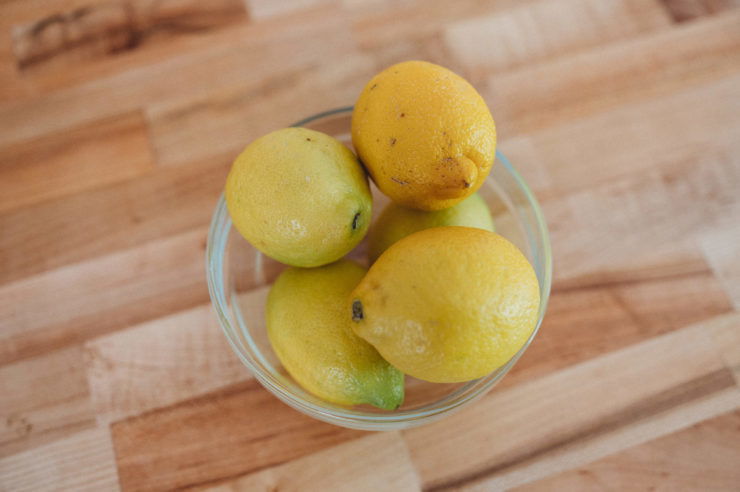
Next, place the whole lemon on your cutting board and firmly press it against the board while rolling it back and forth several times. This will help release some of the internal membranes which will make juicing easier and can provide a slightly higher yield.
Now, hold the lemon horizontally on the cutting board and cut it in half from side to side (across its equator).

The lemon halves are now ready to be used with a reamer, electric juicer, citrus press, or a trusty old fork or spoon.
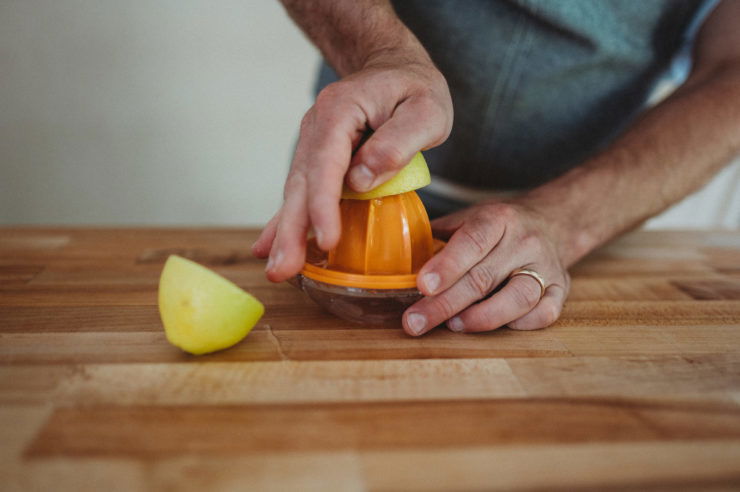
5. Twist
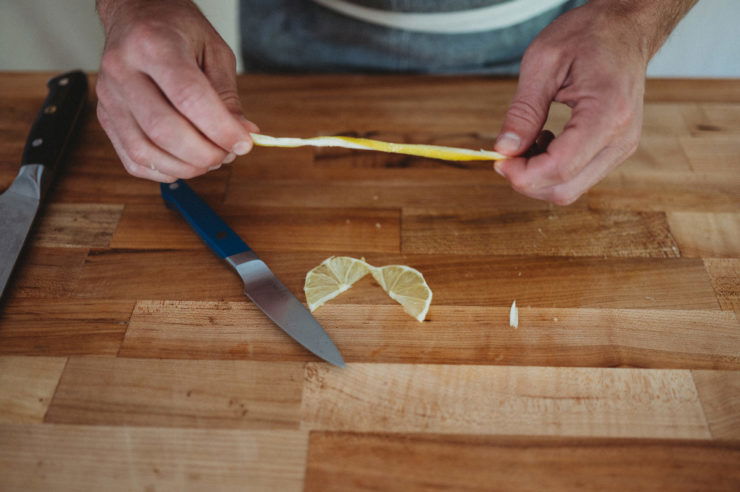
Lemon twists are a great way to gussy up a cocktail, iced tea, or even as a garnish for a dessert. You’ll only be using the lemon skin for these, so save all of the lemon flesh for its juice.
To make a lemon twist, you’ll start by making sliced lemon rounds (#2 above). You’ll want your rounds to be about ¼” thick.
Next, place one of the lemon slices flat on your cutting board and cut through one side of the skin.
Then, take your knife and cut away all of the lemon flesh and most of the pith (the white part below the skin). Leaving a thin layer of pith intact will add a bit more integrity to your twist.
Finally, hold one end of the trimmed peel in one hand and the other end in your other hand. Gently pull the peel so that it is almost straight and twist each end of the peel in opposite directions.
Storing Cut Lemons
Cut lemons are best stored in an airtight container.
The go-to in most restaurants would be plastic deli containers (also my preferred choice at home). But you can just as easily use things like zip-top bags or mason jars.
It’s best to use any cut lemons within 3 or 4 days, but they’re never better than the day you cut them. This is especially true if you’re storing juice, as it can lose its flavor and brightness rather quickly.
In some of the better restaurants where I worked, all citrus juices had to be made daily. It was a real tightrope act, aiming to get just the right amount for that day’s prep and service without going over.
Knowing that not enough juice and service gets a lot harder than it should be, and too much will simply turn into a family-meal beverage (not the worst outcome).
Tools For The Job
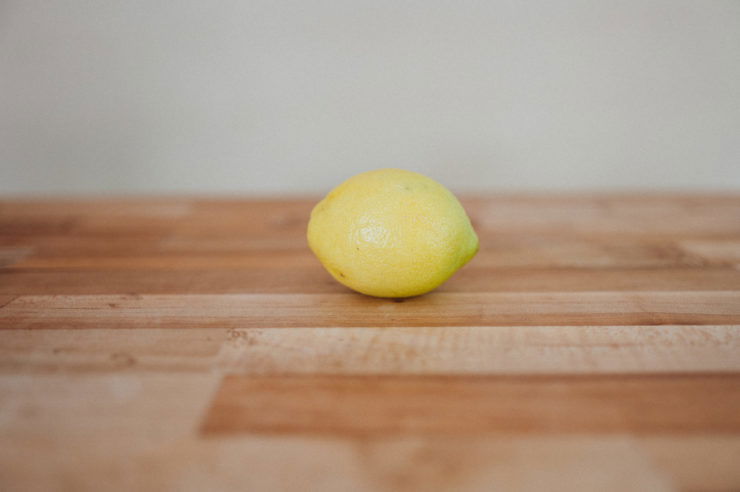
The tools for cutting lemons are pretty minimal. All you really need is a cutting board and a sharp knife. While just about any knife will do, I particularly like using a utility or petty knife (like this Tojiro) when dealing with citrus.
Similar to a paring knife, utility knives are nimble and give you a lot of control, which is great for delicate work like lemon suprémes or twists. But they have the added benefit of a longer blade that’s perfect when you’re peeling a lemon or dealing with larger citrus.
Frequently Asked Questions
Can You Juice A Lemon Without A Knife?
You can juice a lemon without a knife by pressing and rolling it on your countertop, then creating a hole in one end using something like a skewer or toothpick. You can then squeeze the lemon by hand and juice will come out of the small hole.
How Do You Cut A Lemon For A Drink?
You can slice a lemon into thin rounds, half moons, small wedges, or a twist to be used in a drink.
How Long Do Lemon Twists Last?
Lemon twists will last for 3-4 days when stored in the fridge in an airtight container.

How To Cut A Lemon
- Total Time: 5 minutes
- Yield: 1 Serving
Description
Learn how to prep lemons for any use in the kitchen and for maximum juice extraction.
Ingredients
- Lemons, 1 each
Instructions
For Wedges:
- Hold the lemon on its side and cut off the top and bottom.
- Stand the lemon up on one of the now flat ends and slice through the lemon just to the side of its core.
- Rotate the lemon and repeat the cut 2 more times. You should now have 3 lemon “cheeks” and a core.
- Scrape off any remaining seeds and use them “as is.” OR cut the “cheeks” into smaller wedges.
- Squeeze the core to extract additional juice.
For Slices:
- With your non-dominant hand, hold the lemon horizontally on your cutting board and cut off one end.
- Continue to make slices through the lemon using your non-dominant hand as a guide to determine how thick or thin each slice will be.
- To make half-moons, split the lemon in half vertically and place each half cut side down before making your slices.
For Suprémes:
- Hold the lemon on its side and cut off the top and bottom deep enough to expose the lemon flesh.
- Stand the lemon up on one of the flat sides and remove the skin and pith by cutting from top to bottom, following the shape of the lemon.
- After all of the skin and pith is removed, hold the lemon in your hand and make shallow cuts between each lemon segment. Follow the membrane between each segment to remove the lemon flesh.
- Squeeze the remaining core and membranes to extract additional lemon juice.
For Juice:
- If your lemon is in the fridge, remove it and allow it to come to room temperature.
- Firmly press and roll the lemon on your cutting board.
- Hold the lemon horizontally on your cutting board and cut it in half across its equator (side to side).
- Proceed to juice with your preferred method.
For Twists:
- First, cut your lemon into round slices that are ¼” thick.
- Lay the rounds flat on your cutting board and cut through one side of the skin.
- Use your knife to remove all of the lemon flesh, reserve the flesh for another use.
- Hold one end of the skin in each hand, pull almost taught, and twist your hands in opposite directions.
Notes
Before making any type of cut, rinse your lemons thoroughly under cold water
- Prep Time: 5 minutes
- Category: Knife Skills
- Cuisine: Any
Keywords: How To Cut A Lemon, Cutting Lemons, How To Slice A Lemon
Thank you for reading this post How To Cut A Lemon 5 Different Ways at Tnhelearning.edu.vn You can comment, see more related articles below and hope to help you with interesting information.
Related Search:

